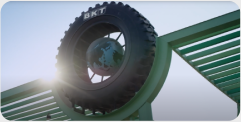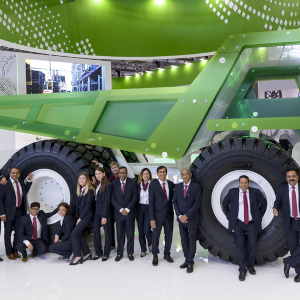Off-roading has a colourful and legendary history that has ‘unpaved’ the way to what we know about off-roading today, and would not have been possible without the invention of the first off-road vehicle. Read our latest article to discover more about the roots of off-roading.
Off-roading is a term that you may well have heard of! It comes in many forms, such as extreme sports: people ripping through turbulent terrains for thrills - not to mention the addictive adrenaline rush they gain from driving a monster truck. Off-roading has a colourful and legendary history that has ‘unpaved’ the way to what we know about off-roading today, and would not have been possible without the invention of the first off-road vehicle.
Kégresse Track
It all goes back to the early twentieth century when Kégresse worked closely with the Czar Nicholas II of Russia, who wanted a custom job for his car in the 1900s. Cars and roads were still in their early stages, and road infrastructure was still primarily built for horses.
As you know, the terrain of Russia is very icy and snowy and much harsher than other countries. The Czar needed a car capable of cruising over snowy landscapes with impeccable style; Kégresse knew just what to do. And, lo and behold, the first off-roader was born.
He fashioned the Kégresse track, named after him, which can be added to cars and trucks. The car is also attached with skis to the front, making the vehicle easily manoeuvrable, able to face challenging, soft terrains, and to go off-road for the first time.
It is a spectacle for sure; it looks like the bottom half of a tank with giant skis on the front wheels and an old-fashioned car replacing the armoured body. Soon, the Czars had Rolls-Royces, Mercedes and other luxury cars converted to off-roaders. Later, the caterpillar tracks would replace the skis. What’s more, his innovations lead to the development of tanks and military vehicles.
The War
A few years later came World War Two. America needed something akin to the valiant horses of World War One that could gallop on multifarious terrains - but more practical, faster and stronger. The tank had its perks, but was very slow and not very agile. Enter: Willys Jeep 4x4.
The US army bid for car manufacturers to create a light reconnaissance vehicle. Bantam, Willys, and Ford were the only brands to respond to the task. The prototype Quad, named after the 4x4 system, was made in a ground-shaking 75 days.
While only two prototypes were made, it led the way to more innovative military fleets of off-road cars and trucks such as Willys MA (16,000 sent to the allies) and Willys MB recognisable Jeep brand. Did you know that one MB was even awarded the Purple Heart? And the Jeep was named "America’s greatest contribution to modern warfare". Horses and motorbikes with sidecars were now obsolete; the Jeep was able to carry artillery weapons and be used as both ambulances and tractors.
Caterpillar tracks are not very useful for everyday consumers and road driving. However, the impressive developments of the iconic Jeep could be perfect for the job. The Jeep CJ (Civilian Jeep) was introduced for post-war commercialism and consumer aspects of off-roading.
Many farmers relied on the Jeep post-war, as a whopping 4 million did not have a truck or a tractor. The Jeep was an affordable way to solve that problem, and it is claimed that it could do the job of two heavy-duty horses for 10 hours a day without overheating.
For a much more in-depth overview of the colourful history of the Jeep, visit their website.
Modern Off-Roading
The commercial moments in the era of the Jeep led to the development of off-roading we know today. Did you know that it directly influenced the Land Rover and other off-roaders that followed? In the 1960s, Ford released the Bronco, aimed at the outdoorsy, adventurous middle class. The Toyota Land Cruiser followed not long after. In the 70s, the classic off-roaders couldn't meet all consumers’ needs, and customers took it upon themselves to customise SUVs (sport utility vehicles) and trucks with raised suspensions to tackle even more demanding terrains.
Before you knew it, the Monster Truck was born. The public witnessed Monster Trucks by the 80s as side acts to motocross, tractor pulling, mud bogging, and ATV racing. Monster Trucks would soon find themselves to be the main act.
Motocross is a well-known off-roading extreme sport where motorcycles race and fly, and athletes can compete with freestyle stunts and tricks.
Truck tractor pulling, or power pulling is a competitive sport where modified tractors pull a weight transfer sledge along a 100 metre track. The sledge gets heavier as it goes down the runway. The driver who is crowned the winner is the one who can drag the sledge the furthest.
Mud bogging, most popular in the USA and Canada, is an off-roading sport where the driver attempts to take their vehicle through a long stretch of boggy ground. The winner is the one who can go the furthest, usually. However, if multiple racers complete the track, the shortest time wins.
ATV racing is a competitive racing sport where drivers go head to head with their ATVs (all-terrain vehicle) - think quad bikes, for example. It is very similar to motocross but with quads rather than motorcycles. Typically, tracks consist of obstacles, mud, dirt, or sand.
Monster Jam, our favourite of all, is one of the most significant off-roading events: a place where athletes and spectacular monster trucks compete to prove who is the best of the best. Monster Jam stemmed from the 70s to the adrenaline-packed phenomenon it is today. With humble origins, Monster Jam showcases over 30 countries worldwide.
From backflips to wheelies and racing up to 70 miles per hour, drivers compete across races, skills challenges, doughnut competitions, and freestyle: a test of physical and mental strength and determination.
There are many aspects of off-roading dominating the automotive world today. From construction to agriculture, to industrial purposes, we wouldn't be here today if it weren't for the passionate off-road enthusiasts and brilliant innovative minds paving the way since Kegresse in the 1900s.
Across the most challenging terrains in the world, BKT has your back. We have tires for your mud-bogging ATV, your farm tractor and even your dumpers and dozers. You can view them all here.






